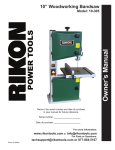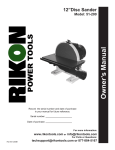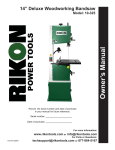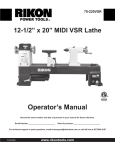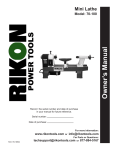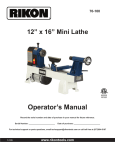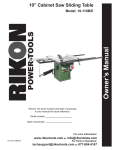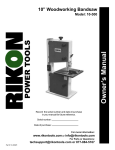Download Rikon Power Tools 10-110B Owner`s manual
Transcript
6” X 48”Belt & 10”Disc Sander Owner’s Manual Model: 50-120 Record the serial number and date of purchase in your manual for future reference. Serial number: Date of purchase: For more information: www.rikontools.com or [email protected] For Parts or Questions: Part # 50-120M2 [email protected] or 877-884-5167 Operator Safety: Required Reading IMPORTANT! Safety is the single most important consideration in the operation of this equipment. The following instructions must be followed at all times. There are certain applications for which this tool was designed. We strongly recommend that this tool not be modified and/or used for any other application other than that for which it was designed. If you have any questions about its application, do not use the tool until you have contacted us and we have advised you. General Safety Warnings KNOW YOUR POWER TOOL. Read the owner’s manual carefully. Learn the tool’s applications, work capabilities, and its specific potential hazards. ALWAYS GROUND ALL TOOLS. If your tool is equipped with a three-pronged plug, you must plug it into a three-hole electric receptacle. If you use an adapter to accommodate a two-pronged receptacle, you must attach the adapter plug to a known ground. Never remove the third prong of the plug. ALWAYS AVOID DANGEROUS ENVIRONMENTS. Never use power tools in damp or wet locations. Keep your work area well lighted and clear of clutter. ALWAYS REMOVE THE ADJUSTING KEYS AND WRENCHES FROM TOOLS AFTER USE. Form the habit of checking to see that keys and adjusting wrenches are removed from the tool before turning it on. ALWAYS KEEP YOUR WORK AREA CLEAN. Cluttered areas and benches invite accidents. ALWAYS KEEP VISITORS AWAY FROM RUNNING MACHINES. All visitors should be kept a safe distance from the work area. ALWAYS MAKE THE WORKSHOP CHILDPROOF. Childproof with padlocks, master switches, or by removing starter keys. NEVER OPERATE A TOOL WHILE UNDER THE INFLUENCE OF DRUGS, MEDICATION, OR ALCOHOL. ALWAYS WEAR PROPER APPAREL. Never wear loose clothing or jewelry that might get caught in moving parts. Rubber-soled footwear is recommended for the best footing. ALWAYS USE SAFETY GLASSES AND WEAR HEARING PROTECTION. Also use a face or dust mask if the cutting operation is dusty. NEVER OVERREACH. Keep your proper footing and balance at all times. NEVER STAND ON TOOLS. Serious injury could occur if the tool is tipped or if the cutting tool is accidentally contacted. 2 ALWAYS DISCONNECT TOOLS. Disconnect tools before servicing and when changing accessories such as blades, bits, and cutters. ALWAYS AVOID ACCIDENTAL STARTING. Make sure switch is in “OFF” position before plugging in cord. NEVER LEAVE TOOLS RUNNING UNATTENDED. ALWAYS CHECK FOR DAMAGED PARTS. Before initial or continual use of the tool, a guard or other part that is damaged should be checked to assure that it will operate properly and perform its intended function. Check for alignment of moving parts, binding of moving parts, breakage of parts, mounting, and any other conditions that may affect its operation. A guard or other damaged parts should immediately be properly repaired or replaced. Special Safety Rules For Belt & Disc Sanders 1. Do not operate this machine until you have read all of the following instructions. 2. Do not attempt to operate this machine until it is completely assembled. 3. Do not turn ON this machine if any pieces are missing. 4. If you are not familiar with the operation of the machine, obtain assistance from a qualified person. 5. It is highly recommended that this machine be firmly mounted to a flat and secure work surface or stand. 6. Always wear protective eyewear prior to operating this machine. 7. Do not operate this machine if you are under the influence of drugs and/or alcohol. 8. Remove all jewelry prior to operating this machine. 9. Do not wear any gloves while operating this machine. 10. Always make sure the power switch is in the OFF position prior to plugging in the machine. 11. Always make sure the power switch is in the OFF position when doing any assembly or setup operation. 12. Always wear a dust mask and use adequate dust collection and proper ventilation. Use of sanders can produce harmful particles while sanding certain types of woods. 13. The use of any accessories or attachments not recommended may cause injury to you and damage your machine. 14. This machine must be properly grounded. 15. Abrasive discs and belts should be the recommended width and length of the manufacturer. 16. Always keep your face and hands clear of moving parts such as belts and pulleys. 17.Keep power supply cords free of moving parts of the sander. Damaged cords can result in electric shock. 18. Maintain a 1/16” clearance between the sanding disc, sanding belt and tables. 19.Always support the workpiece with the table or backstop. 20. Remove material or debris from the work area. Keep work area neat and clean. 21.Keep these instructions for future reference. SAVE THESE INSTRUCTIONS. Refer to them often. 3 Table of Contents Safety Warnings..................................................................................................................................2-3 Sander Safety Rules ..........................................................................................................................3 Specifications ........................................................................................................................................4 Contents of Package ............................................................................................................................................5 Assembly ...........................................................................................................................6-8 Electrical Requirements ...........................................................................................................................................9 Operation............................................................................................................10-11 Maintenance ...................................................................................................................................12 Changing the Motor Belt............................................................................................................................12 Trouble Shooting...............................................................................................................................................13 Wiring Diagram.................................................................................................................................13 Parts List .....................................................................................................................................14 Parts Explosion...........................................................................................................................................15 Notes .............................................................................................................................................16 Warranty .............................................................................................................................................17 Specifications Belt Size Belt Speed Disc Size Disc Speed Table Size Belt Table Tilt Disc Table Tilt Motor Amps Volts Net weight 6”x48” 2030 SFPM 10” 1720 SFPM 4” x 8” 0-90 o 0-45 o 3/4 HP 10A 110V 104 lbs 4 Contents of Package When unpacking, check to make sure the following parts are included. If any parts are missing or broken, please call RIKON Power Tools at the number on the cover of this manual as soon as possible. Carton Contents Item A Description Belt & disc sander assembly Qty 1 B Sanding disc 1 C Table support w/scale 1 D Table support 1 E Work table for belt 1 F Miter Gauge 1 G Work table for disc 1 H Locking knob for table support 2 I Mount, support table 1 J Mount, support table w/indicator 1 K Bag of loose parts 1 H Owner’s manual 1 List of loose parts in bag Description Qty Sunk head screw M6x16 2 Washer 6mm 2 Knurled nut M6 Description Qty Pan head screw M6x16 4 Lock washer 6mm 4 2 Washer 6mm 2 Hex. bolt 4 Hex “L” wrench 3mm 1 Lock washer 4 Hex “L” wrench 6mm 1 5 Assembly Securing Sander Base Assembly to Workbench The sander base must be secured before using. Attach a large C-Clamp to each side of the sander and the workbench. Or, permanently mount following the instructions below: 1. Place the sander on the workbench in its final operating location. 2. Place a pencil through the mountong holes of the sander base (42) and mark the hole locations on workbench. Fig. 01 3. Remove sander and drill four 3/8 inch holes through the workbench. 4. Align sander base over holes and secure using four 5/16 inch screws (or larger) and hex nuts. (See Fig. 01) Mounting Sanding Disc and Guard 1. Locate sanding disc (22) and peel backing off disc. 2. Align perimeter of sanding disc over plate. When aligned, press disc firmly onto disc. Fig. 02 3. Position disc guard (27) onto lower portion of sanding disc so that the mounting holes align. 4. Using a Phillips screwdriver, fasten two pan head screws (found in parts bag) through disc guard. (See Fig. 02) Installing the Belt Table 1. Place the work table for belt on the work support. 2. Insert two countersink head screws through work table and the work support slot. 3. Put a 6mm washer and a wing nut on the screw and tighten. (See Fig. 03) Fig. 03 6 Installing the Disc Table Assembly Warning: To avoid jamming the workpiece or fingers between the table and sanding surface, the table edge should be a maximum of 1/16 in from sanding surface. 1. Use two M6x16 pan head screws to fasten the table support mount to the front of sander. 2. Place the support table w/scale onto the table support mount. Fig. 04 3. Put a 6mm flat washer on the table lock knob, and place the knob into the tilt scale plate and mount. Hand tighten it only at this time. (See Fig. 04) 4. Place the table onto table support; align the four screws which are preassembled under the table with the holes of table support. (See Fig. 05) 5. Put the external lock washer and hex nut onto the screws, and tighten. Fig. 05 6. Adjust the table and retighten the table lock knobs. 7. Loosen the four M6 hex nuts under the table. 8. Use a 1/16 inch drill bit as a spacer. Place the drill bit between the disc and the front edge of the table. Hold the table against the 1/16 inch drill bit and tighten the four M6 hex nuts. (See Fig. 06) Leveling Table Assembly Warning: To avoid injury from accidental start, make sure tool is unplugged before making any adjustments. Fig. 06 1. Using a combination square, check the angle of work table with the disc. (See Fig. 07) 2. If the table is not 90 degrees with the disc, loosen the table lock knob screw and tilt table. 3. Adjust worktable square to the disc and retighten the table lock knob. 4. Adjust the pointer to the zero mark on the scale plate. Fig. 07 7 Installing the Sanding Belt Warning: To avoid injury from accidental start, make sure tool is unplugged before making any adjustments. On the under side of the sanding belt, you will find a “direction arrow”. The sanding belt must run in the direction of this arrow so that the splice does not come apart. Fig. 08 1. Slide tension lever to the right to release the belt tension. (See Fig. 08) 2. Place the sanding belt over the drums with the direction arrow pointing in the proper direction. (See Fig. 09) Make sure the belt is centered on both drums. 3. Slide tension lever to the left to apply belt tension. 4. Tighten hex socket screw when bed is in desired position. Fig. 09 Tensioning and Tracking 1. Plug in the power cord. Turn the switch “ON” and immediately “OFF”, noting if the belt tends to slide off the idler drum or drive drum. 2. If the sanding belt moves toward the disc, turn the tracking knob clockwise 1/4 turn. (See Fig. 10) 3. If the sanding belt moves away from the disc, turn the tracking knob counterclockwise 1/4 turn. 4. Turn switch “ON” and immediately “OFF” again, noting belt movement. Readjust tracking knob if necessary. Fig. 10 On/Off Switch The On/Off Locking Switch needs to have the switch key inserted before the switch can be used (key located in parts bag). This feature prevents unauthorized use of the sander. (See Fig. 11) CAUTION: Never walk away from sander when machine is running. Always lock the switch in the Off position and unplug from the power supply when not in use. Fig. 11 8 Electrical Requirements In the event of a malfunction or breakdown, grounding provides a path of least resistance for electric current to reduce the risk of electric shock. This tool is equipped with an electric cord having an equipment-grounding conductor and a grounding plug. The plug must be plugged into a matching outlet that is properly installed and grounded in accordance with all local codes and ordinances. Do not modify the plug provided. If it will not fit the outlet, have the proper outlet installed by a qualified electrician. Improper connection of the equipment-grounding conductor can result in a risk of electric shock. The conductor, with insulation having an outer surface that is green with or without yellow stripes, is the equipment-grounding conductor. If repair or replacement of the electric cord or plug is necessary, do not connect the equipment-grounding conductor to a live terminal. Check with a qualified electrician or service personnel if the grounding instructions are not completely understood, or if in doubt as to whether the tool is properly grounded. Use only three wire extension cords that have three-prong grounding plugs and three-pole receptacles that accept the tool’s plug.* Repair or replace a damaged or worn cord immediately. This tool is intended for use on a circuit that has an outlet that looks the one illustrated in Figure A below. The tool has a grounding plug that looks like the grounding plug as illustrated in Figure A below. A temporary adapter, which locks like the adapter as illustrated in Figure B below, may be used to connect this plug to a two-pole receptacle, as shown in Figure B if a properly grounded outlet is not available.** The temporary adapter should only be used until a properly grounded outlet can be installed by a qualified electrician. The green colored rigid ear or tab, extending from the adapter, must be connected to a permanent ground such as a properly grounded outlet box. * Canadian electrical codes require extension cords to be certified SJT type or better. ** Use of an adapter in Canada is not acceptable. 9 Operation Bevel Sanding The work table can be tilted from 0 to 45 degrees for bevel sanding. Loosen the table lock knob and tilt the worktable to desired angle as shown. (See Fig. 12) Retighten table lock knob. Warning: To avoid jamming the workpiece or fingers between the table and sanding surface, the table should repositioned on the table support to retain a maximum of 1/16” distance between sanding surface and table. Fig. 12 Positioning the Belt Bed A bed locking hex socket head screw locks the belt bed in a vertical or horizontal position. To adjust vertical position: 1. Remove the work support. 2. Loosen the hex socket head locking screw using a 1/4 inch hex wrench. (See Fig. 13) 3. Position the belt bed vertically as shown and tighten the hex socket head locking screw. Fig. 13 Surface Sanding on the Sanding Belt Warning: To avoid injury from slips, jams or thrown pieces, adjust the backstop to clear the sanding surface by no more than 1/16th of and inch. When checking clearance between the belt and work support, use a 1/16” drill bit as a spacer gauge. (See Fig. 14) 1. Hold the workpiece firmly with both hands, keeping fingers away from the sanding belt. Fig. 14 2. Keep the end butted against the backstop and move the work evenly across the sanding belt. Use extra caution when sanding very thin pieces. (See Fig. 15) 3. For sanding long pieces, remove the work support. 4. Apply only enough pressure to allow the sanding belt to remove material. Fig. 15 10 End Sanding on the Sanding Belt To sand the end of a long workpiece, it is recommended to sand with the belt in the vertical position. 1. To raise the belt to the vertical position, follow the instructions in “Positioning Belt Bed” on the previous page. 2. Install the worktable assembly. 3. Move the work evenly across the sanding belt. (See Fig. 16) Fig. 16 Sanding Curved Edges Always sand inside curves on the idler drum as shown.(See Fig. 17) Warning: Never attempt to sand the ends of a workpiece on the idler drum, applying the end of the workpiece to the idler drum could cause the workpiece to fly up and result in an injury. Fig. 17 Always sand outside curves on the left side of center on the sanding disc as shown. (See Fig. 18) Warning: Applying the workpiece to the right side of the disc could cause workpiece to fly up (kickback) and result in an injury. Fig. 18 Sanding Small End Surfaces on the Sanding Disc Note: Use of a miter gauge is recommended for this operation. Always move the work across left side of center on the sanding disc face as shown. (See Fig. 19) Warning: Applying the workpiece to the right side of the disc could cause workpiece to fly up( kickback) and result in an injury. Fig. 19 11 Maintenance Warning: For your safety, remove the plug from power source outlet before adjusting, maintaining, of lubricating your belt and disc sander. 1. Apply a light coat of paste wax to the worktable to make feeding stock easier, and reduce rust. 2. Use compressed air to frequently blow out dust and debris from sander and motor. (See Fig. 20) Warning: To avoid electrocution or fire, any repairs to electrical systems should be done only by qualified service technicians. Unit must be reassembled exactly to factory specifications. Fig. 20 3. If power cord is worn, cut, or damaged in any way, have it repaired immediately. Changing the Motor Belt 1. Using a Phillips screwdriver, remove the three pan head screws located in the cover. (See Fig. 21) 2. Remove the cover. Fig. 21 3. Loosen four M8 hex head screws to allow the pulleys to shift enough to place belt around them. Place belt around motor pulley and drive pulley as shown. (See Fig. 22) 4. Adjust tension of the belt by putting a wrench in adjusting gap. Push up on wrench to tighten tension between pulleys. 5. Tighten the four M8 hex head screws carefully. 6. Test belt tension by placing fingers on either side of the belt and squeeze. There should be about a 1/4 inch give to the belt. (See Fig. 23) Fig. 22 Note: Too much tension on pulley belt may cause increased noise and over load the motor. Not enough tension on the pulley belt may cause belt to fail prematurely. 7. Locate the pulley cover and position inside the edges of pulley housing. 8. Using a Phillips screwdriver, reinstall and tighten the three pan head screws. Fig. 23 12 Troubleshooting SYMPTOM PROBABLE CAUSE REMEDY Sander does not operate 1. Not plugged into wall outlet. 2. Locking key is not inserted. 3. Power switch defective. 4. Motor or wiring problem. 1. Plug into wall outlet. 2. Insert locking key. 3. Replace power switch. 4. Take to a qualified technician. Motor slows when sanding 1. Timing belt is too tight. 2. Applying too much pressure on work piece. 1. Decrease tension. 2. Apply less pressure to work piece when sanding. Sanding Belt runs off drums 1. Not tracking proplerly. 1. Adjust tracking. Wood burns while sanding 1. Sanding Disc or Belt is loaded with debris. 1.Clean or replace disc or belt. Sander makes excessive noise 1. Timing belt too tight, bearings need oil. 1. Decrease tension, oil bearings. Wiring Diagram 13 Parts List Key No. 39 40 41 42 43 44 45 46 47 48 49 50 51 52 53 54 55 56 57 58 59 60 61 62 63 64 65 66 67 68 69 70 71 72 73 74 75 76 77 Key No. Description Part No. 1 Sanding Belt 152x1219mm 1-JL61020032 2 Bed 1-JL61021000-050W 3 Knob 1-JL20061101/2-001S 4 Washer 1-WSH8GB96B 5 Wing screw 1-JL61040006 6 Sunk head screw M6x16 1-M6X16GB818B 7 Work table for belt 1-JL61040008-050W 8 Work support, sander belt 1-JL61040007-001S 9 Lock pin, work support 1-JL61040004 10 Wing nut M6 1-JL20061003-001S 11 Lock wahser-helical 5mm 1-WSH5GB862D2Z 12 Pan head Screw M5x8 1-M5X14GB818B 13 Pan head Screw M5x16 1-ST4D2X25GB845B 14 Switch housing 1-JL60062001-049S 15 No-volt switch 1-J-9301B 17 Bearing spacer 1-JL61020008 18 Bearing cap 1-JL61020007 19 Socket head screw M8x10 1-M8X10GB80B 20 Drive drum 1-JL61020006 21 Cover, switch Housing 1-JL60062002-049S 22 Pad-254mm dia. Sander paper 1-JL61020033 23 Screw-pan cross M6x12 1-M6X10GB70Z 24 Disc 1-JL61030001 25 Support, sanding disc 1-JL61030002 26 Tapping screw M4x12 1-M5X40GB70Z 27 Disc guard 1-JL61010005-050W 28 Disc shroud 1-JL61010006-001S 29 Hex nut M6 1-M6GB6170Z 30 Pan head screw M6x16 1-M6X16GB5781Z 31a Mount, table support, left 1-JL61030005-001Y 31b Mount, table support, right 2-JL61034000-001Y 32a Table support, left 2-JL61032000-001Y 32b Table support,right 2-JL61033000-001Y 33 Table 1-JL61030010-001G 34 Dust collector 1-JL61010003-001S 35 Pan head screw M5x16 1-M5X16GB818B 36 Clamp handle 1-JL61010014-001Y 37 Handle 1-JL61010013-050W 38 Pan head screw M5x16 1-M6X16GB818B 14 Description Part No. Cast Base 1-JL61010001-001G Motor Cover 1-JL61010002-001S Safety guard, sanding belt lower 1-JL61010012-001S Pan head screw M5x8 1-M5X10GB818Z Thread M6x145 1-M6X145GB818Z Rubber sleeve 1-JL61010011-001S Support stem 1-JL61010010 Lock base sander belt 1-JL61020026-001G Motor 1-G3512674 Hex head screw 1-M8X16GB5781Z Lock washer 1-WSH8GB93Z Drive Pulley 1-JL61020027 Countersink Washer 1-WSH6GB5287Z Drive pulley 1-JL61020001 Pulley Cover 1-JL61010004-001S Timing Belt 1-JL61020034 Drive Pulley 1-JL61020002 Flat head screw M5x25 1-M6X20GB70Z Bearing support 1-JL61020004 Lock plate sander plate 1-JL61020005-050A Hex socket cap screw M8x25 1-M8X25GB5783B Retaining ring 15mm 1-CLP15GB894D1B Ball Bearing 1-BRG80202GB278 Drive Shaft 1-JL61020025 Panhead screw M5x16 1-M5X16GB818B Rubber washer 1-JL61020021-001S Tension Lever 1-JL61020023-050W Lever Spacer 1-JL61020013 Rubber washer 1-JL60020018 Index spring 1-JL61020020 Rubber bushing 1-JL61020022 Retaining ring 12mm 1-CLP12GB894D1B Ball bearing 1-BRG80101GB278 Idler Drum 1-JL61020017 Idler Shaft 1-JL61020016 Drum guide 1-JL61022000 Index spring 1-JL61020015 Power cord w/plug 1-JL20072101 “D” shape rubber bushing 1-JL61010009-001S Parts Explosion 15 Notes 16 Warranty 2-Year Limited Warranty RIKON Power Tools/Richen Enterprise, Inc. (“Seller”) warrants to only the original retail consumer/purchaser of our products that each product be free from defects in materials and workmanship for a period of two (2) years from the date the product was purchased at retail. This warranty may not be transferred. This warranty does not apply to defects due directly or indirectly to misuse, abuse, negligence, accidents, repairs, alterations, lack of maintenance or normal wear and tear. Under no circumstances will Seller be liable for incidental or consequential damages resulting from defective products. All other warranties, expressed or implied, whether of merchantability, fitness for purpose, or otherwise are expressly disclaimed by Seller. This warranty does not cover products used for commercial, industrial or educational purposes. This limited warranty does not apply to accessory items such as blades, drill bits, sanding discs or belts and other related items. Seller shall in no event be liable for death, injuries to persons or property, or for incidental, contingent, special, or consequential damages arising from the use of our products. To take advantage of this warranty proof of purchase documentation, which includes date of purchase and an explanation of the complaint, must be provided. The Seller reserves the right to effect at any time, without prior notice, those alterations to parts, fittings, and accessory equipment which they may deem necessary for any reason whatsoever. To take advantage of this warranty, please fill out the enclosed warranty card and send it to: RIKON Warranty 110 Cummings Park Woburn, MA 01801 The card must be entirely completed in order for it to be valid. If you have any questions please contact us at 877-884-5167 or [email protected]. 17 For more information: 110 Cummings Park Woburn, MA 01801 877-884-5167/781-933-8400 [email protected] www.rikontools.com Copyright Richen Enterprise, Inc. 2005 Printed in China 6/06


















